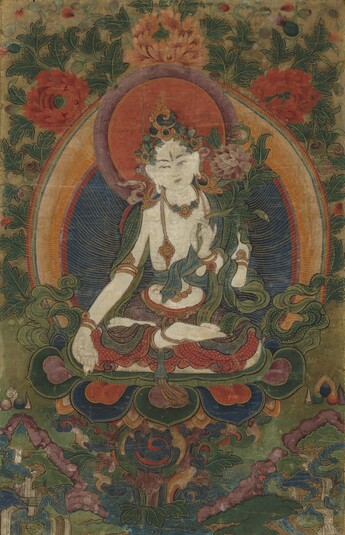
Item: Tara (Buddhist Deity) - White
| Origin Location | Tibet |
|---|---|
| Lineages | Buddhist |
| Material | Ground Mineral Pigment on Cotton |
| Collection | Private |
Classification: Deity
Appearance: Peaceful
Gender: Female
White Tara, (Tibetan: drol ma kar mo): the female Buddha of longevity. (See the White Tara Main Page and Tara Outline Page).
From the point of view of Tantric literature Tara is a completely enlightened buddha. According to her early story as a young bodhisattva practitioner she promised that after achieving enlightenment she would always appear in the form of a female bodhisattva and goddess for the benefit of all beings. She further promised to especially protect beings from the eight fears.
In this white form of the deity she appears specifically for the purpose of bestowing longevity - long life and health. Practiced in all Schools of Tibetan Buddhism it can probably be said that Tara is second in popularity only to Avalokiteshvara. Her practices are found in all classes of tantric literature of both the old Nyingma traditions and the new Sarma schools from India.
"...with a hue white like an autumn moon - radiant like a stainless crystal jewel, shining with rays of light, one face, two hands, and having three eyes; with the conduct of having sixteen years of age. The right hand is in the mudra of supreme generosity; the left holds with the thumb and forefinger the stem of a white utpala to the heart with the petals blossoming at the ear. Representing the buddhas of the three times the single stem is divided into three, in the middle is a blossoming flower, the right in fruition, the left in the form of a bud; adorned with various jewel ornaments; having various silk upper garments and a lower garment of red silk; seated with the legs in vajra posture. The palms of the hands and feet each have an eye - the seven eyes of pristine awareness." (Sachen Ngagwang Kunga Lodro, 1729-1783).
It should be noted that there are different forms of White Tara. The most popular and well known depictions are as seen here in this example. There is another form, almost identical to the one above, where she only has two eyes on the face and not the extra eye on the forehead and palms of the hands and feet.
Jeff Watt 1-2014
View other items in the Thematic Set: Buddhist Deity: Tara, White Main Page

